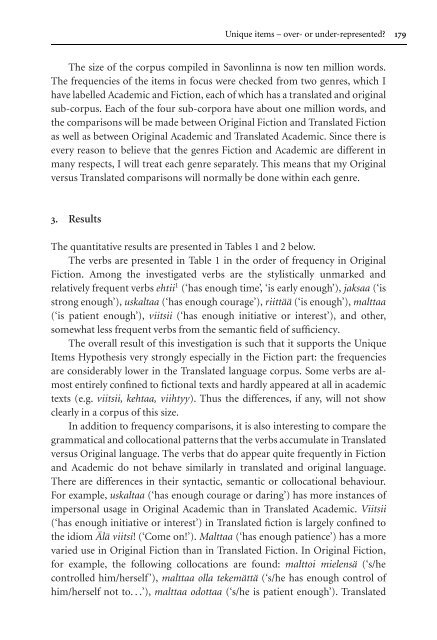Translation Universals.pdf - ymerleksi - home
Translation Universals.pdf - ymerleksi - home
Translation Universals.pdf - ymerleksi - home
Create successful ePaper yourself
Turn your PDF publications into a flip-book with our unique Google optimized e-Paper software.
Unique items – over- or under-represented? 179<br />
The size of the corpus compiled in Savonlinna is now ten million words.<br />
The frequencies of the items in focus were checked from two genres, which I<br />
have labelled Academic and Fiction, each of which has a translated and original<br />
sub-corpus. Each of the four sub-corpora have about one million words, and<br />
the comparisons will be made between Original Fiction and Translated Fiction<br />
as well as between Original Academic and Translated Academic. Since there is<br />
every reason to believe that the genres Fiction and Academic are different in<br />
many respects, I will treat each genre separately. This means that my Original<br />
versus Translated comparisons will normally be done within each genre.<br />
3. Results<br />
The quantitative results are presented in Tables 1 and 2 below.<br />
The verbs are presented in Table 1 in the order of frequency in Original<br />
Fiction. Among the investigated verbs are the stylistically unmarked and<br />
relatively frequent verbs ehtii 1 (‘has enough time’, ‘is early enough’), jaksaa (‘is<br />
strong enough’), uskaltaa (‘has enough courage’), riittää (‘is enough’), malttaa<br />
(‘is patient enough’), viitsii (‘has enough initiative or interest’), and other,<br />
somewhat less frequent verbs from the semantic field of sufficiency.<br />
The overall result of this investigation is such that it supports the Unique<br />
Items Hypothesis very strongly especially in the Fiction part: the frequencies<br />
are considerably lower in the Translated language corpus. Some verbs are almost<br />
entirely confined to fictional texts and hardly appeared at all in academic<br />
texts (e.g. viitsii, kehtaa, viihtyy). Thus the differences, if any, will not show<br />
clearly in a corpus of this size.<br />
In addition to frequency comparisons, it is also interesting to compare the<br />
grammatical and collocational patterns that the verbs accumulate in Translated<br />
versus Original language. The verbs that do appear quite frequently in Fiction<br />
and Academic do not behave similarly in translated and original language.<br />
There are differences in their syntactic, semantic or collocational behaviour.<br />
For example, uskaltaa (‘has enough courage or daring’) has more instances of<br />
impersonal usage in Original Academic than in Translated Academic. Viitsii<br />
(‘has enough initiative or interest’) in Translated fiction is largely confined to<br />
the idiom Älä viitsi!(‘Comeon!’).Malttaa (‘has enough patience’) has a more<br />
varied use in Original Fiction than in Translated Fiction. In Original Fiction,<br />
for example, the following collocations are found: malttoi mielensä (‘s/he<br />
controlled him/herself’), malttaa olla tekemättä (‘s/he has enough control of<br />
him/herself not to. . .’), malttaa odottaa (‘s/he is patient enough’). Translated
















